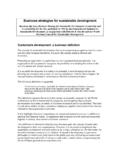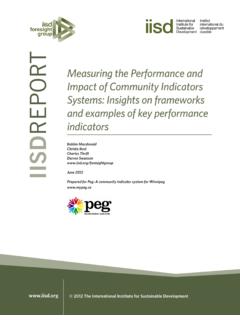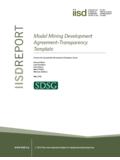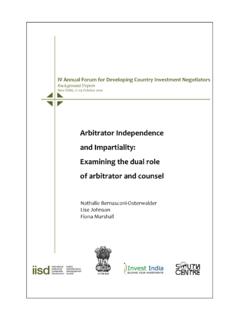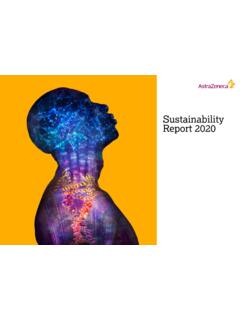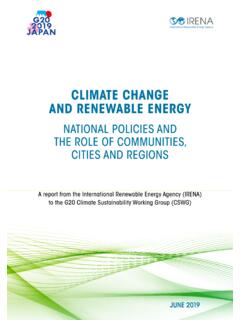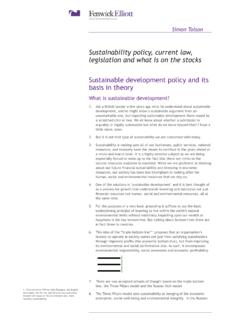Transcription of Global Market Report: Tea
1 SUSTAINABLE COMMODITIES. MARKETPLACE SERIES 2019. Global Market Report: Tea Vivek Voora, Steffany Berm dez, Cristina Larrea Series Editor: Sofia Bali o Global Demand for Tea Is Growing Despite China, Sri Lanka and Kenya, which account for half sustainability challenges of the world's tea production, the majority of tea is produced by smallholder ,8 Production is Tea, a dried leaf infused beverage derived from the concentred in a few countries, with the top seven leaves of a small shrub originally from China, has growing countries accounting for 90 per cent of the become the world's second most popular beverage after Global tea supply in water, with 3 billion cups consumed every day across the ,2 In 2017.
2 Total tea production accounted The largest tea-exporting countries in 2017 were China for million tonnes, of which approximately 35 per (USD billion), Sri Lanka (USD billion) and cent was exported, worth USD 8 ,4,13 That same Kenya (USD billion), while the largest importing year, the sector had a retail value of approximately countries were Pakistan (USD 550 million), Russia USD 50 ,6 Tea was grown in 48 countries (USD 525 million) and the United States (USD. in 2016, including 12 Low Human Development 487 million).10,11 A significant amount of tea is also Countries (LHDCs). Tea production employs 13 consumed domestically.
3 For instance, the amount of tea million people, 9 million of whom are smallholder consumed in China, India and Turkey in 2015 was more farmers, while the remainder work in tea estates; in than in all other tea-consuming nations Standard-Compliant Tea Accounted for At Least of Total Tea Production in 2016. Figure 1. Global tea production trend, 2008 6,000,000. 5,500,000. 5,000,000. Metric Tonnes VSS Compliant 4,500,000 Potentially VSS Compliant Conventional 4,000,000. 3,500,000. 3,000,000. 2008 2009 2010 2011 2012 2013 2014 2015 2016. Note:VSS-compliant production volumes refer to tea produced in compliance with one or more VSSs.
4 Conventional production volumes do not comply with any existing VSS. Production volumes that are defined as potentially VSS-compliant cannot be definitively listed in either category with the data currently available. How Much Tea is Certified by Each Standard? the Market was made up of tea compliant with Voluntary sustainability Standards (VSS), versus per cent in Figure 2. Standard-compliant tea production 2008. However, only per cent of tea production is volumes in potentially VSS-compliant, thus leaving 74 per cent of tea as conventional. According to the FAO and a number of Market research Rainforest Alliance companies, the tea sector is expected to grow at a 1,084,910 MT compound annual growth rate (CAGR) of about 4 to per cent from 2017 to 2024 and is projected to reach USD 73 billion in retail value by 19.
5 Despite this positive projection, the tea industry faces important challenges that are unique to the Fairtrade International sector. Access to tea-processing facilities is essential for tea estates and smallholder tea farms to remain 253,870 MT. viable, as picked leaves need to be processed within 6 hours. Therefore, international tea manufacturers have established their processing plants close to the UTZ Certified fields, which has created a vertically integrated value 119,642 MT chain. In fact, the tea supply chain is controlled by a small number of companies, which has resulted in a high level of vertical and horizontal integration.
6 Organic approximately 85 per cent of tea is sold by a few 87,830 MT multinational companies, and 20 per cent of the Global Market is controlled by the three largest tea ,20 Consequently, it is necessary to Global tea supply growth outpaced demand growth in establish a more equitable wealth distribution across 2016 and 2017 at rates of per cent and per cent, tea supply chains to improve the sustainability of respectively, resulting in a surplus of approximately the sector. Furthermore, 70 per cent of Global tea 200,000 tonnes for both ,12,13 The Global supply production is sold via auctions through anonymous demand balance of tea closed in 2018 with a small transactions, in which intermediaries can easily switch surplus and this trend is projected to continue until between suppliers, pushing down prices and reducing ,13 As tea-producing countries are also the margins for Tea cultivation areas are also largest consumers of tea, production and consumption geographically limited.
7 As tea is a sensitive crop are strongly The Food and Agriculture that requires specific growing conditions to Organization of the United Nations (FAO) reports a Climate change is also expected to affect temperature balanced production and consumption growth of about and rainfall patterns, which can significantly impact per cent between 2007 and Tea estates are already reporting heavier rains and longer dry seasons leading to increased soil erosion The sector is projected to experience continued growth and further use of fertilizers, pesticides and irrigation due to increasing demand primarily from Asian and to maintain Additional challenges Pacific countries, particularly those experiencing facing the tea sector include forced and child labour.
8 Increasing incomes; a growing clientele among young which are still rampant; poor tea plantation working urban consumers; interest in the health benefits of conditions; low wages; and pesticide residues in the drinking tea; and the expansion of new products and final ,22 24. flavourings, such as ready-to-drink tea, premium tea, and herbal and fruit 19 In addition, demand for green tea is expected to outpace demand for black ,12,19 The considerable expansion of sustainable tea products is also worth noting. In 2016, per cent of Demand for More Sustainably Produced Tea Is Growing and Could Help Address the Sector's LIVELIHOODS.
9 challenges Over 13 million people employed in tea production Voluntary sustainability StandardsA (VSS) have been 9 million smallholder farmers used in the tea sector for almost 40 years to address 70% of Global production comes from 8 million smallholder farmers in Asia and Africa the various challenges facing the sector and to provide tea consumers with more sustainable VSS- compliant tea is produced to meet consumer preferences Market VALUE. while aiming to maintain the sector's long-term Over USD 2 Billion VSS-compliant tea sustainability by requiring agricultural practices that based on 2016 tea producer prices enable climate resilience, prevent soil erosion, lower pesticide use, increase profitability for smallholders, and improve workers' conditions, such as providing the right CAGR 2008 2016.
10 To collective bargaining and access to sanitation and Conventional production is up by clean drinking while VSS production is up by 35%. Demand for more sustainable tea historically came VSS production in LHDC Tanzania is up by 79%. from outside producing countries, primarily from Europe and North America. Tea producers with the resources to become VSS-compliant saw an opportunity TEA PRODUCTION IN LHDCS. to access these potentially lucrative export markets 5% of total tea produced while being able to fall back on the growing domestic 12% of VSS-compliant tea produced ,26 Considering their significance in meeting based on 2016 data Global demand for more sustainable tea, VSSs have had an important role in improving the working conditions of tea workers and the profitability of VSSs aim to create a virtuous cycle where demand for VSS-compliant tea comes from Africa (Kenya, Malawi, more sustainable tea results in better conditions for the Rwanda) and Asia (India, Turkey, Indonesia).

